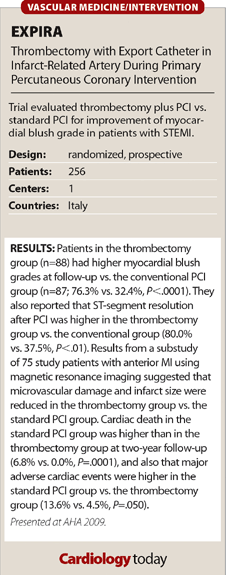EXPIRA: Thrombectomy plus PCI linked with ST-segment resolution, improved myocardial blush grade
Infarct size was also reduced in the thrombectomy group.
American Heart Association Scientific Sessions 2009
Patients treated with thrombectomy plus percutaneous coronary intervention were more likely to have ST-segment resolution and improve myocardial blush grade than those receiving standard PCI alone.
Researchers for the single-center EXPIRA study enrolled 256 patients with STEMI and randomly assigned 175 of them to either thrombectomy plus PCI (n=88) or standard PCI (n=87). The primary study endpoint was a final myocardial blush grad of >2 and 90 minutes of ST-segment resolution of more than 70% of the ST segment. Patients were included if they had STEMI within six to nine hours following symptom onset, had angiographically identifiable occlusive thrombus and a TIMI score of either zero or one at the time of initial angiography.
According to the study results, patients in the thrombectomy group had higher myocardial blush grades at follow-up vs. the conventional PCI group (76.3% vs. 32.4%, P<.0001). They also reported that ST-segment resolution after PCI was higher in the thrombectomy group vs. the conventional group (80.0% vs. 37.5%, P<.01). Results from a substudy of 75 study patients with anterior MI using MRI suggested that microvascular damage and infarct size were reduced in the thrombectomy group vs. the standard PCI group. Cardiac death in the standard PCI group was higher than in the thrombectomy group at two-year follow-up (6.8% vs. 0.0%, P=.0001), and also major adverse cardiac events were higher in the standard PCI group vs. the thrombectomy group (13.6% vs. 4.5%, P=.050).
“A pretreatment with manual thrombectomy results in a lower cardiac mortality and a lower incidence of other major adverse cardiac events at two-year follow-up,” Gennaro Sardella, MD, a professor of invasive cardiology at Policlinico Umberto I University La Sapienza in Rome, said in his presentation. “We observed that the occurrence of cardiac death and major adverse cardiac events is significantly related to final myocardial blush grade and ST-segment resolution.” – by Eric Raible
For more information:
- Sardella G. LB01 #43. Presented at: American Heart Association Scientific Sessions 2009; Nov. 14-18, 2009; Orlando, Fla.

![]()
It is good that we have increasing evidence because this is one technique [in which] the evidence has lagged behind clinical practice.
– Alice K. Jacobs, MD
Director, Interventional Cardiology
Boston Medical Center

![]()
The story is not completely finished because the ICE-T trial is coming along, and that will be on intracoronary thrombolysis in the setting of thrombus burden. The whole issue is still evolving and it is important that we not jump to conclusions. The enthusiasm for the technique so far has outstripped the data to support it.
– Peter C. Block, MD
Cardiology Today Co-Section Editor

